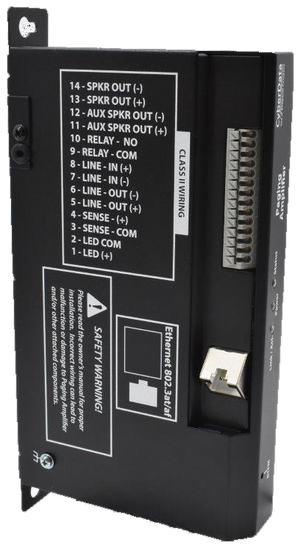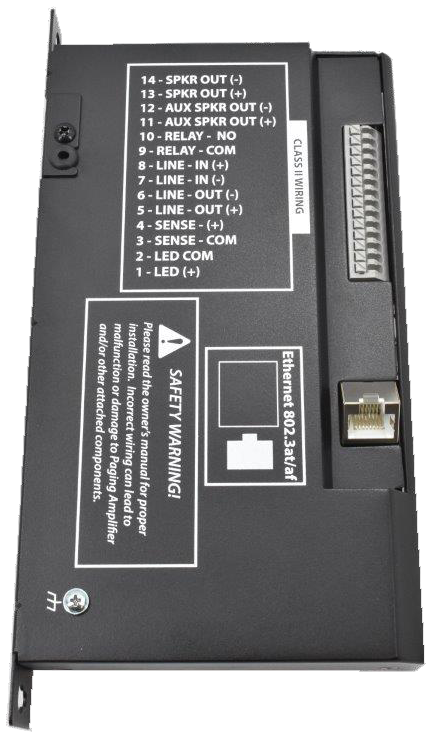011324 SIP Paging Amplifier
Part Number: 011324
MSRP: $627.00
- Description
- Features
- Specs
- FAQs
- Installation
- Downloads
The SIP Paging Amplifier is a Power over Ethernet (802.3at) VoIP paging device and loud ringer for use in places that need loud paging. It provides an easy method for implementing an IP-based overhead paging system for your existing or new VoIP Phone system.
- Concurrent SIP and multicast paging
- Loud/Night Ringer function - second SIP extension
- Paging Prioritization
- Support for 10 multicast paging groups
- 9 user-uploadable page messages
- Can receive pages directly from Poly phones as well as other devices that can send standard multicast
- Sense input capable of generating events or SIP calls
- Supports delayed pages, i.e. call buffering
- Support for security code to prevent unwanted SIP calls
- Support for auxiliary strobe
- Line-in for background music
- Line-out connector
- DTMF controlled relay
- Supports up to two 011471 IP66 Analog Horns or other 8 Ohm speaker
- Network volume control
- TLS 1.2 and SRTP enhanced security for IP Endpoints in a local or cloud-based environment
- Autoprovisioning via HTTPS, HTTP or TFTP
- HTTPS web based configuration
- Configurable event generation for device health and status monitoring
- 802.11q VLAN tagging
- HTTPS command interface
- Support for Cisco SRST resiliency
| Ethernet I/F | 10/100 Mbps |
| Protocol | SIP RFC 3261 Compatible |
| Power Input | PoE 802.3at or 802.3af |
| Audio Output |
802.3at: 117.9 (+/- 0.2) dBC @1M and 1kHz* 802.3af: 115.1 (+/- 0.2) dBC @1M and 1kHz* |
|
Line In: Intput Signal Amplitudes Input Impedance |
2.0 VPP Maximum 10k Ohm |
|
Line Out: Output Signal Amplitudes Output Level Total Harmonic Distortion Output Impedance |
2.0 VPP Maximum +2dBm nominal 0.5% maximum 10k Ohm |
| On-Board Relay | 1A @ 30 VDC |
| Payload Types | G.711 a-law, G.711 µ-law, G.722, and G.729 |
| Network Security | TLS 1.2, SRTP, HTTPS |
| Operating Range |
Temperature: -40 degrees C to 55 degrees C (-40 degrees F to 131 degrees F) Humidity: 5-95%, non-condensing |
| Storage Temperature | -40 degrees C to 70 degrees C (-40 degrees F to 158 degrees F) |
| Storage Altitude | Up to 15,000 ft. (4573 m) |
|
Dimensions** |
1.10 in. [29.0 mm] Length 4.20 in. [107.0 mm] Width 8.50 in. [215.0 mm] Height |
|
Weight Boxed Weight |
1.27 lbs. [0.57 kg] 2.0 lbs. [0.90 kg] |
| Compliance | CE: EMC Directive – Class A EN 55032 & EN 55024, LV Safety Directive – EN 62368-1; RoHS Compliant; FCC Part 15 Class A; Industry Canada ICES-3 Class A; IEEE 802.3 Compliant; TAA Compliant |
| Warranty | 5 Years Limited |
| Part Number | 011324 |
*When used with the optional 011471 IP66 Analog Horn (sold separately)
**Dimensions are measured from the perspective of the product being upright with the front of the product facing you.
What is multicast?
IP multicast is a technique for one-to-many communication over a local IP network. IGMP multicast is sent via UDP packets from a multicast server to a multicast receiver. This stream scales to a larger receiver population by not requiring prior knowledge of who or how many receivers there are. Multicast uses network infrastructure efficiently by requiring the source to send a packet only once, even if it needs to be delivered to many receivers. The network replicates the packet in order to reach multiple receivers only when necessary.
Multicast is a great alternative to SIP registration as it does not require that the recipient of the stream to register as an extension on an IP-PBX server.
CyberData products support both regular IGMP multicast as well as proprietary Polycom Group Paging.
How do I update my firmware?
Check to see if your current firmware is the latest version before attempting to update. Download the latest version firmware which includes the Update Firmware Utility. To upload the firmware from your PC, see the Upgrading the Firmware section of the VoIP Paging Amplifier Operations Guide.
For additional support or answers to questions not covered on this page, who should I contact?
Contact CyberData VoIP Technical Support.
How many horns can be connected to an amplifier?
CyberData's VoIP Paging Amplifier supports the following outputs: One 8-ohm speaker: 8 watts One 8-ohm speaker with external PoE power injector (CyberData PN 010867): 10 watts Two 8-ohm speaker in parallel with external PoE power injector (CyberData PN 010867): 16 watts
Are your speakers compliant with RFC 3261?
Yes, our speakers are compliant with RFC 3261, but not every SIP extension is fully supported such as extensions for certain phone features that our speakers do not require.
Do your speakers support other protocols?
Our speakers are SIP endpoints that use the SIP protocol in RFC 3261. Depending on the business case, we will consider custom applications using other protocols. Please contact sales@cyberdata.net for inquiries concerning other protocols.
Our IP-PBX server is RFC 3261 compliant in that it can register other SIP endpoints, so how do I create multiple paging zones using your speakers?
Our speakers do not create multiple zones as this is a feature (SIP extension) of the IP-PBX server. If your IP-PBX server does not support this SIP extension, you can use our Paging Server product to create multiple zones with our speaker.
Which IP-PBX servers do your speakers interoperate with?
Our speakers interoperate with the IP-PBX servers in the following link.
I hooked up your speakers using Asterisk and they play audio individually but why don't they play in a paging group (zone)?
1)Make sure you have installed and loaded a timing source such as Zaptel's "ztdummy" on your Asterisk server.
2) If you are using SIP phones in the same paging group as our speakers and auto-answer is activated for these phones, please upgrade to the latest paging group module in Asterisk, which is 1.2.3 or greater and put an "x" (this removes auto-answer commands our speakers do not use because they are hard-coded to auto-answer) after the extension number for the speakers in the paging group drop-down menu in FreePBX.
What are the Asterisk settings to set up our paging speakers?
For both IP Speaker and the Paging Amplifier, the settings are contained in the sip_additional.conf file in Asterisk. This file should read as follows in which "100" represents the username of our speaker and the password (secret) is ext100:
[100] username=100 type=friend secret=ext100 record_out=Adhoc record_in=Adhoc qualify=no port=5060 nat=never mailbox=100@device host=dynamic dtmfmode=rfc2833 context=from-internal canreinvite=no callerid=100 <100>
How do I set up a page group in Asterisk?
Page groups are found in the extensions_additional.conf file in Asterisk. The paging group portion of this file should read as follows in which "101 and 102" are the usernames and extensions of two speakers and "103" is the extension used to call the paging group of speakers 101 and 102, and "105" is the extension to call speakers 101,102, and 104:
[ext-paging] include => ext-paging-custom exten => PAGE102,1,GotoIf($[ ${CALLERID(number)} = 102 ]?skipself) exten => PAGE102,n,Dial(SIP/102,5) exten => PAGE102,n(skipself),Noop(Not paging originator) exten => PAGE101,1,GotoIf($[ ${CALLERID(number)} = 101 ]?skipself) exten => PAGE101,n,Dial(SIP/101,5) exten => PAGE101,n(skipself),Noop(Not paging originator) exten => PAGE104,1,GotoIf($[ ${CALLERID(number)} = 104 ]?skipself) exten => PAGE104,n,Dial(SIP/104,5) exten => PAGE104,n(skipself),Noop(Not paging originator) exten => Debug,1,Noop(dialstr is LOCAL/PAGE102@ext-paging&LOCAL/PAGE101@ext-paging) exten => Debug,n,Noop(dialstr is LOCAL/PAGE104@ext-paging&LOCAL/PAGE102@ext-paging&LOCAL/PAGE101@ext-paging) exten => 103,1,Page(LOCAL/PAGE102@ext-paging&LOCAL/PAGE101@ext-paging) exten => 105,1,Page(LOCAL/PAGE104@ext-paging&LOCAL/PAGE102@ext-paging&LOCAL/PAGE101@ext-paging); end of [ext-paging]
Are you able to traverse the NAT with your IP paging products?
Our IP paging products are programmed to traverse the NAT using Session Border Controllers (SBCs) of the VoIP hosting company or service provider. The SBCs act as an outbound proxy and manage the SIP traffic between the SIP server and the SIP endpoint behind the NAT. For more information on SBCs, go here.
Is it possible with one Paging Amplifier to have multiple paging groups?
Since the VoIP Paging Amplifier is a single SIP endpoint, it can not have multiple paging groups.
Are the speaker contacts potential-free?
Yes, our loudspeaker outputs are potential free. If no paging input occurs, the outputs is at or near zero voltage.
What are the output levels of the speaker contacts?
The output level is 15 Volt maximum.
What 8 ohm speakers are recommended for the Paging Amplifier?
CyberData's 011068 Loudspeaker.
My speakers are not loud enough. What should I do?
CyberData recommends good quality speaker wire that is 16 gauge and a maximum length of 25 feet. For maximum output, use two 8-Ohm speakers that are wired in parallel with the shortest possible cable length (total combined length should not exceed more than 25 feet). By utilizing the high power jumper settings described in the manual in conjuction with CyberData's PoE Injector, you may achieve additional speaker volume by using either one 8-Ohm speaker or two 8-Ohm speakers in parallel.
How do I configure Music-on-Hold (MOH) for Asterisk?
Use the instructions at the following link to set up MOH for Asterisk: https://www.voip-info.org/wiki-Asterisk+config+musiconhold.conf
We would like to communicate directly to your products. Do you have any open source programs you can recommend to do this?
Yes. Try the following links and also contact CyberData support for help Data format: RTP audio 8k G.711 a/u Law 20ms packet time Open source programs:
MAST: https://www.aelius.com/njh/mast/ MAST can handle ulaw and alaw as well as streaming from a mic to a speaker.Linphone: https://www.linphone.org/index.php/eng Linphone has a test application called rtpsend that streams data out as ulaw by default. (It may be trivial to modify this to send in other formats).
After a period of time, my device stops working or is unreachable.
This is a common problem when the re-registration time value is not set correctly. On our device, you need to make sure that the re-registration time value (in minutes) is less than that is set on the IP-PBX server.
On an Asterisk-based VoIP SIP PBX system, the CyberData SIP Device status is "Busy" or "Unreachable". I have set up both the CyberData VoIP SIP device and the PBX extension information for the device. I can see the device on the network, am able to PING it, and can bring up the device web page with a browser. However, when I try to call it from a phone extension, I see the word "Busy" or "Unreachable" in the Asterisk log.
In the PBX setup page for the extension of the CyberData device, find the Qualify= value and change it to NO. If the Qualify= value requires a numeric value, then change it to 0.
Note that on some Asterisk systems (such as Intuitive Voice) this value is called the Heartbeat= value. Set the Heartbeat= value to NO, and then save the settings.
Also, on the product's SIP Setup page, make sure that the Register Expiration (minutes) setting is set to less than 6 minutes (5 minutes is good) because it needs to be a value less than the Asterisk default value of 6 minutes. Save the settings after changing the Register Expiration (minutes) setting.
I upgraded my 3CX PBX server to 7.1 and now my Rev B CyberData VoIP IP Speaker and My VoIP Paging Amplifier do not stay registered with the server.
There is a 3CX version 7.1 registration / timing bug. To correct this problem, complete the following steps:
1. Log into the 3CX PBX system, and select SETTINGS -> ADVANCED -> CUSTOM PARAMETERS.
2. Scroll down to select the NONCEEXPIRATION parameter.
3. Change the NONCEEXPIRATION value from 1 to 2 and save the changes.
Note: There are pictures of the 3CX PBX pages and parameters at the end of the document at this link.
When connecting two 8 ohm speakers to the product while in standard low power mode, the unit will reset at full volume pages.
The connection of two 8 ohm speakers in parallel under both Standard and High Power Mode require the use of the CyberData PoE injector.
Are there a set of specs. or standards that define proper spacing for your IP Speakers? We need to determine the proper number of speakers for our buildings' corridors. I am looking for something that considers ceiling height and room size/shape to suggest the appropriate quantity.
The speaker calculator on your website seems sufficient for square rooms. It is hallways that I am struggling with. The hallways measure 9 feet x 9 feet by 100-150 feet in length.
In a ceiling mount, you would want about 1 per every 10-15 feet of hallway length.
If you used the paging amp you could use 3 paging amps per 100 feet as per this drawing.
This assumes average ambient noise and surface attenuation levels.
The following figure shows the 011061 V2 Paging Amp and the 011068 Horn Loudspeaker:

I am unable to connect with the unit when it is plugged into a Cisco SLM 224P switch.
The cables or switch ports that you are connecting to are set in switch or hub mode instead of endpoint stations. The MDIX setting needs to be changed to MDI since our VoIP products are end stations.
From the Cisco SLM 224P User Guide:
Change to MDI:
MDI / MDIX Â Displays the Media Dependent Interface (MDI) / Media Dependent Interface with Crossover (MDIX) status on the port. Hubs and switches are deliberately wired the opposite of the way end stations are wired, so that when a hub or switch is connected to an end station, a straight through Ethernet cable can be used, and the pairs are matched up properly. When two hubs or switches are connected to each other, or two end stations are connected to each other, a crossover cable is used to ensure that the correct pairs are connected. The possible field values are:
MDIX Â Use for hubs and switches. MDI Â Use for end stations.I have a Cisco 6513 switch. When I plug in a CyberData VoIP device, the device constantly reboots and will not register to the SIP server.
Please adjust the switch power selection to Power inline static, as opposed to Power inline dynamic. This will allow the device to continuously receive 15.4W of power.
How do I connect a 600 Ohm Lo-Z input or output to the V2 Paging Amplifier's Line Input or Output?
The V2 Paging Amplifier's Line Input and Output can be connected to a 600 Ohm Lo-Z input or output using a Hi-Z to Lo-Z impedance matching transformer. For example, the Bogen WMT1A input matching transformer is an easy to use, inexpensive solution that does not require soldering or complex wiring.
We have registered the device on Cisco Call Manager but are unable to register the device's Nightringer using the device's MAC address. How do I configure two extensions on Call Manager for the device?
Create a second directory number and user for the Nightringer extension. You may need to fudge a digit of the MAC Address so that Call Manager allows you to associate it to the new user. Be sure this MAC address does not match any other CyberData devices on your network.
I have a Cisco Catalyst 2900 series switch. How do I set the unit so that it can use the PoE (under 15.4w) instead of an external power source?
There are known PoE limitations with third party devices on the Cisco Catalyst series switches. This includes the 2500, 3500, and 6500 series switches. It would be best to avoid using the Cisco Catalyst series switches to power the amplifier and use an 802.3at injector. If you have a 2960-S series switch with PoE+ ports, we recommend that you use those instead of PoE and set the amplifier to High Power mode.
High Power mode DIP switch settings: 1
ON 2 N/A 3 OFF 4 ONBe sure to turn power policing off if it has been enabled on your switch. Power policing is disabled by default. Also, configure your port for no shutdown.
Use the following command to configure inline power: power inline static max 30000
I am looking for an approved panic button to connect to your amplifiers that has a cover over the panic button to avoid accidental pressing and also one that may be waterproof for outside use.
See the following webpage for a nice selection: https://www.sti-usa.com/pcategories/waterproof_buttons_and_switches/
Typical Installation 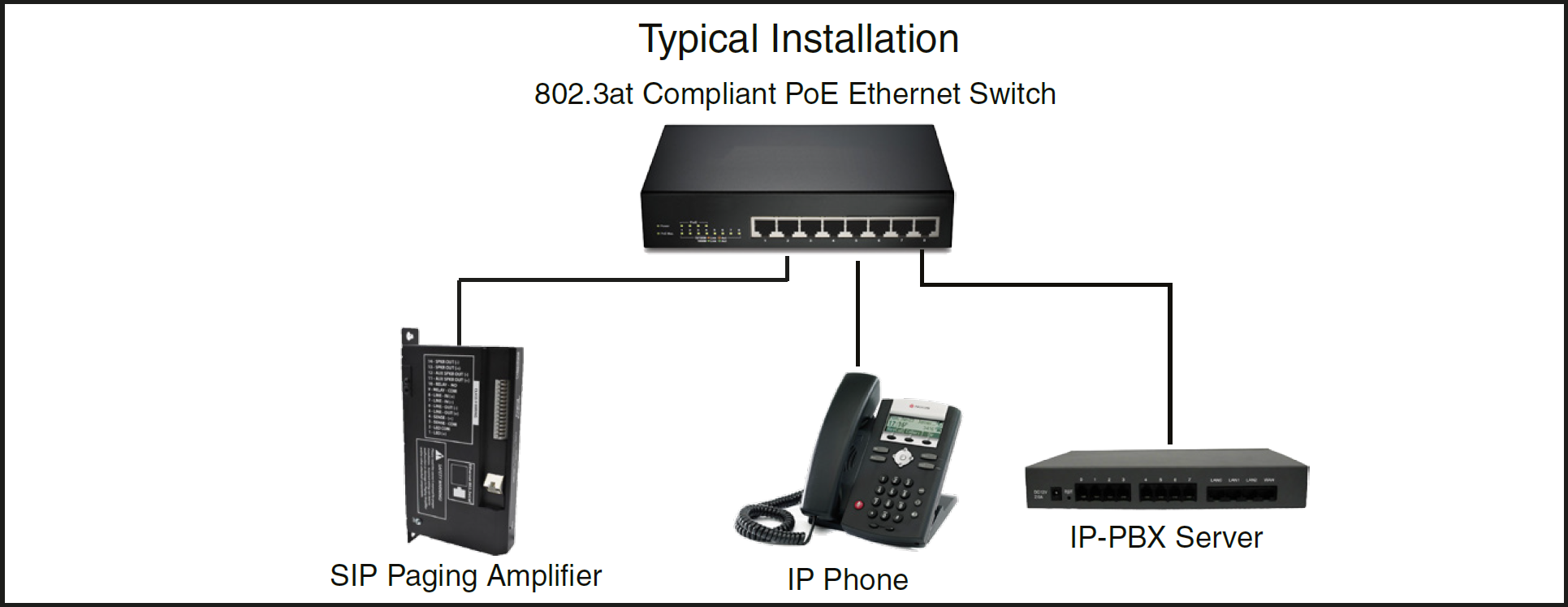
Connecting the Auxiliary RGB Strobe Kit to the Paging Amplifier 
Low Power Mode One Speaker 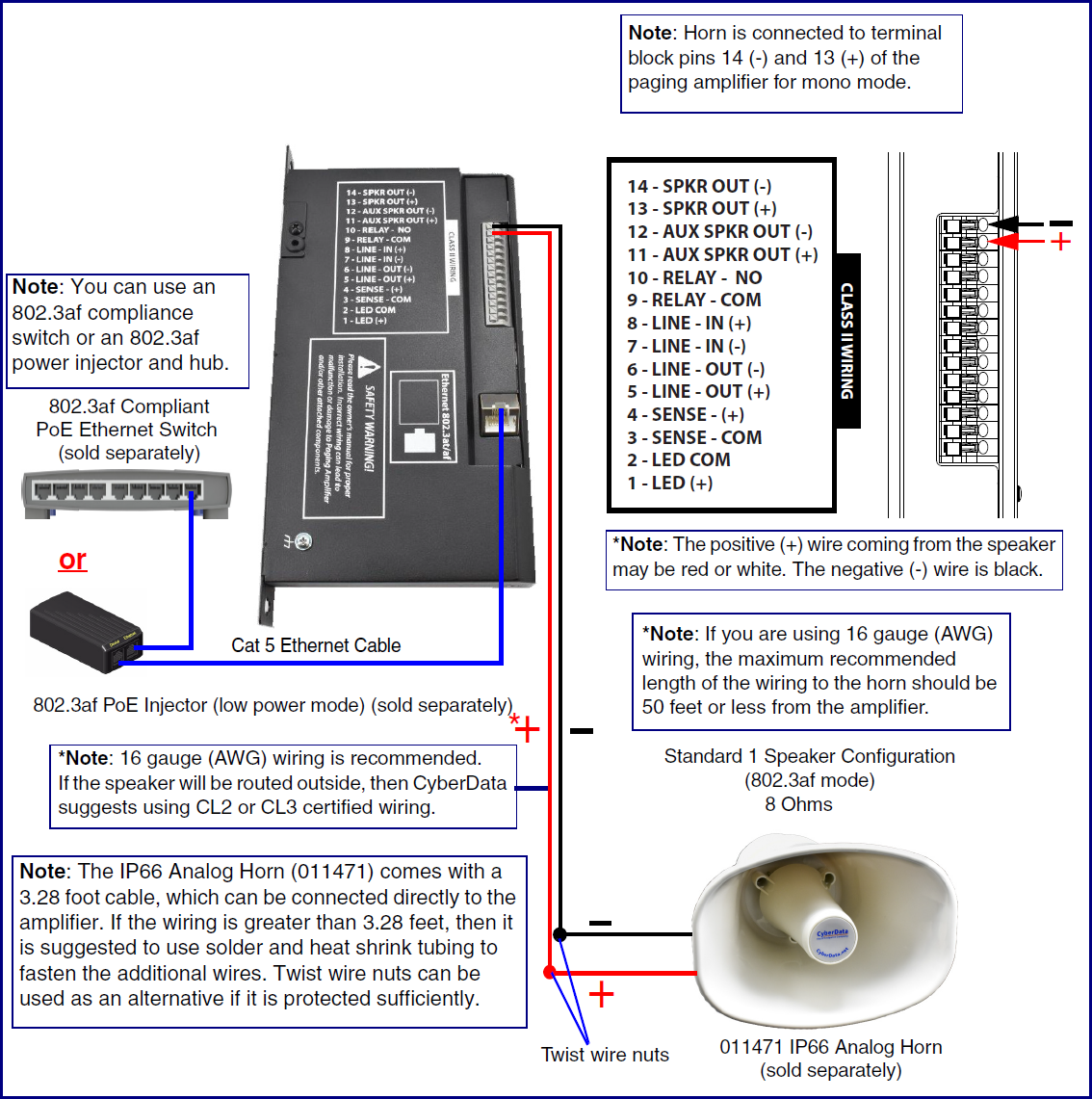
High Power Mode One Speaker 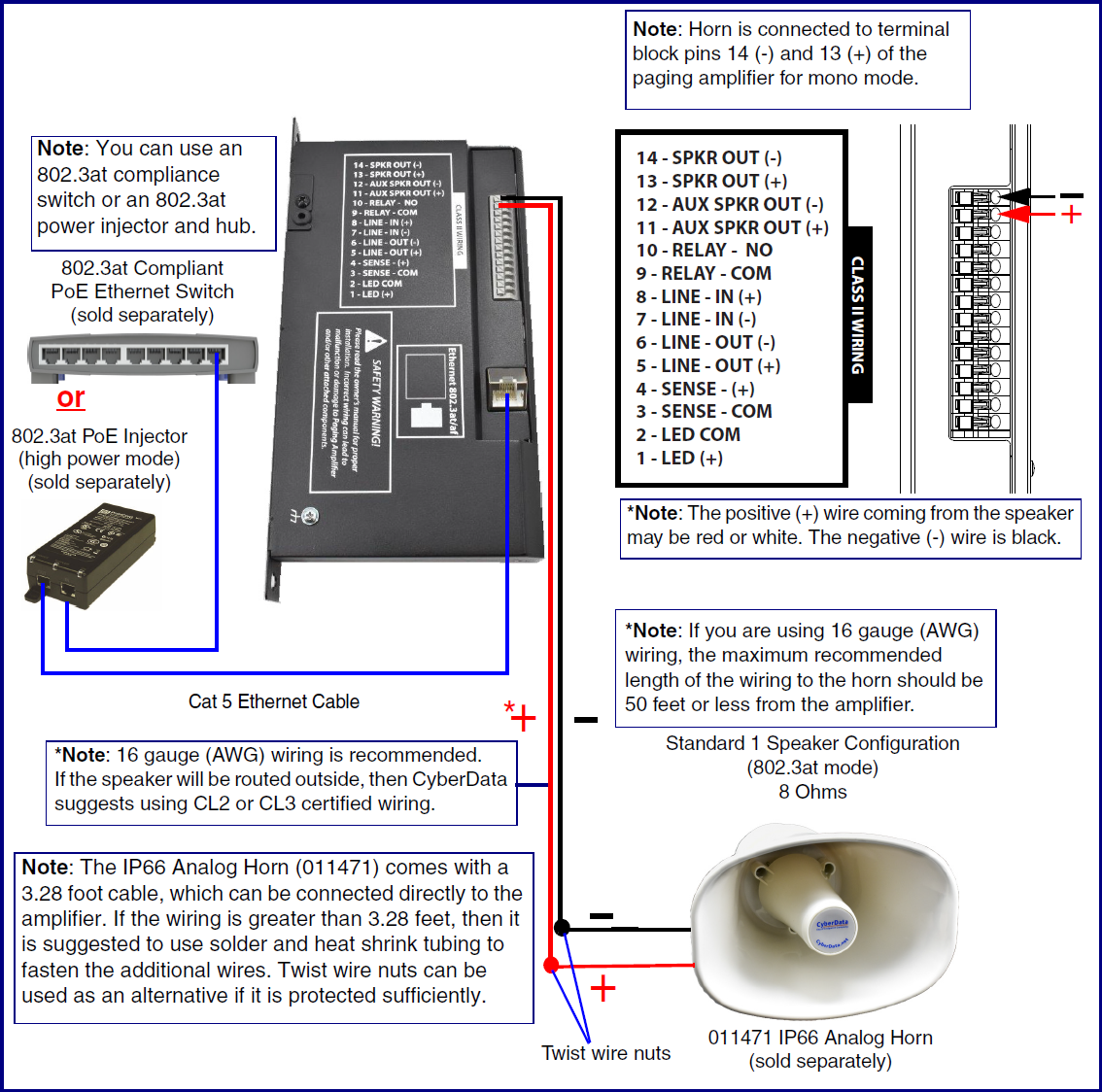
High Power Mode Two Speakers 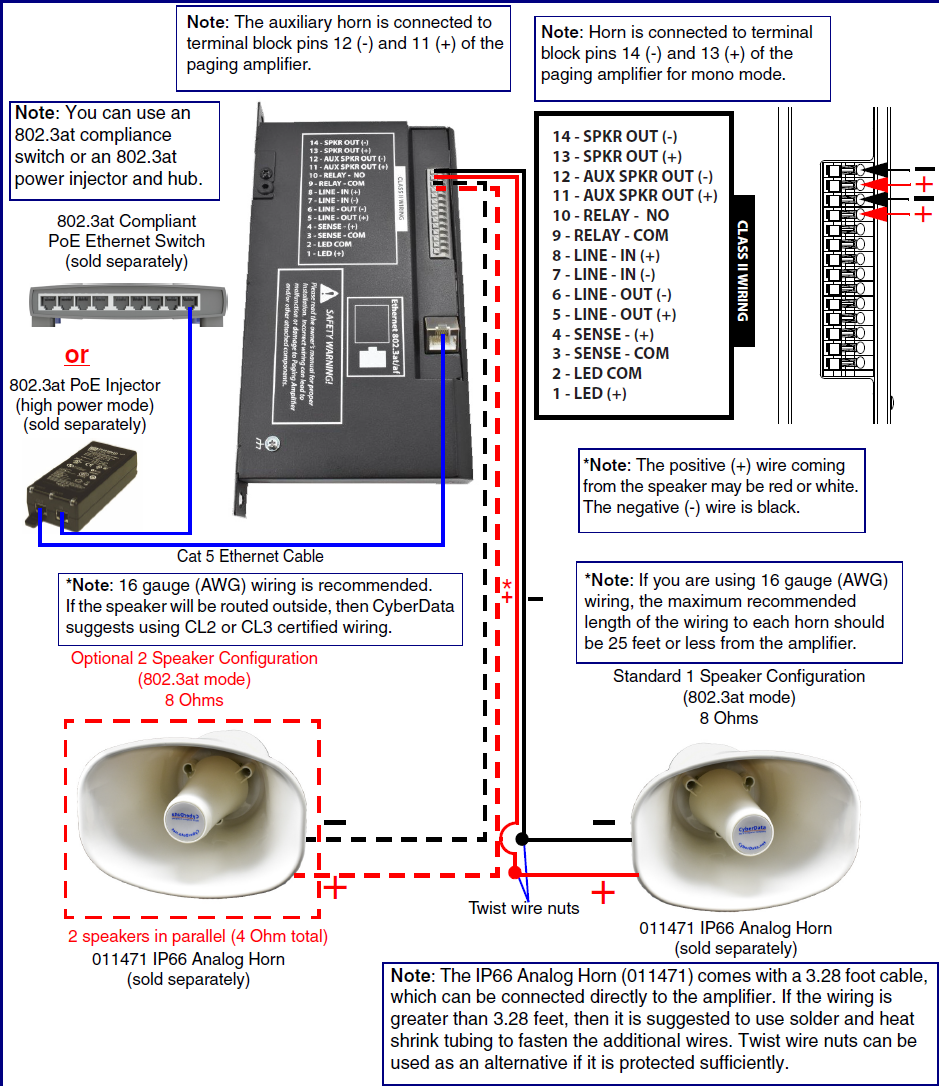
Typical Warehouse Paging Setup 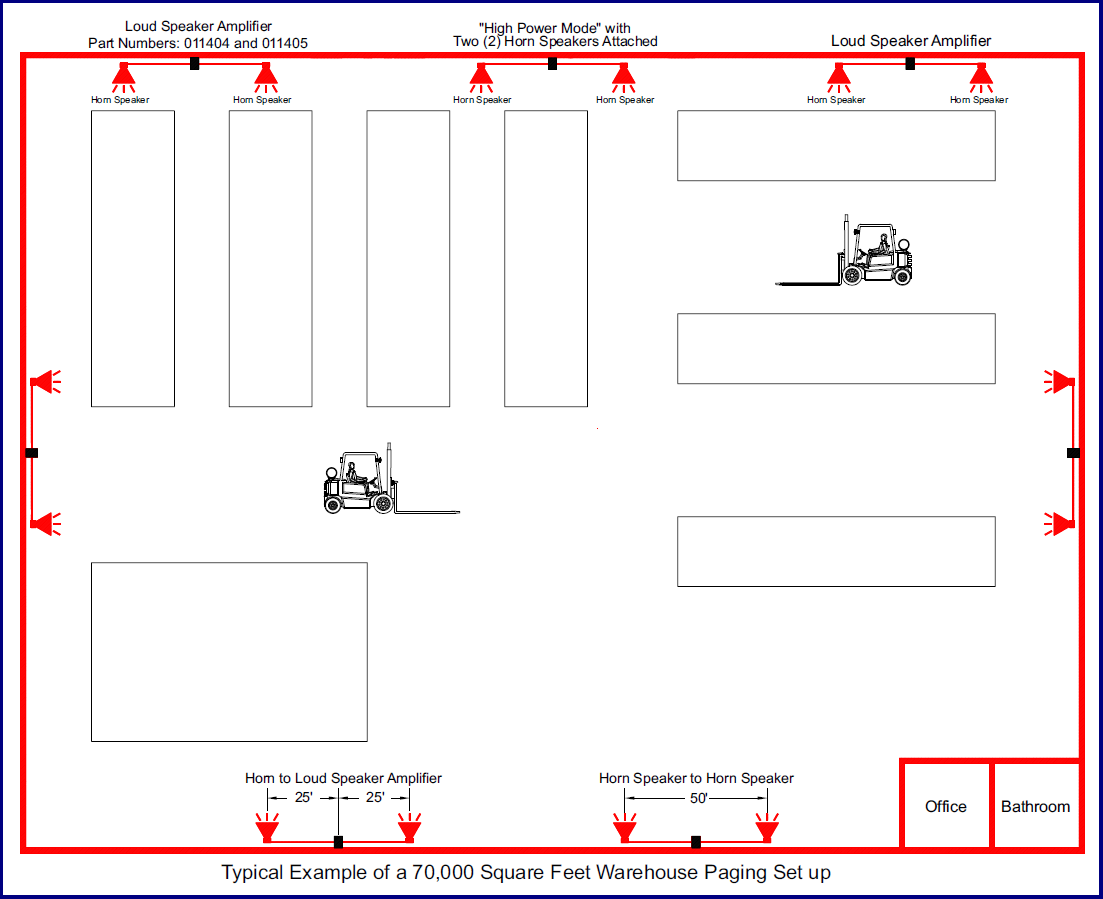
Replacing the Speaker Wire
Suggested Outdoor Installation for Security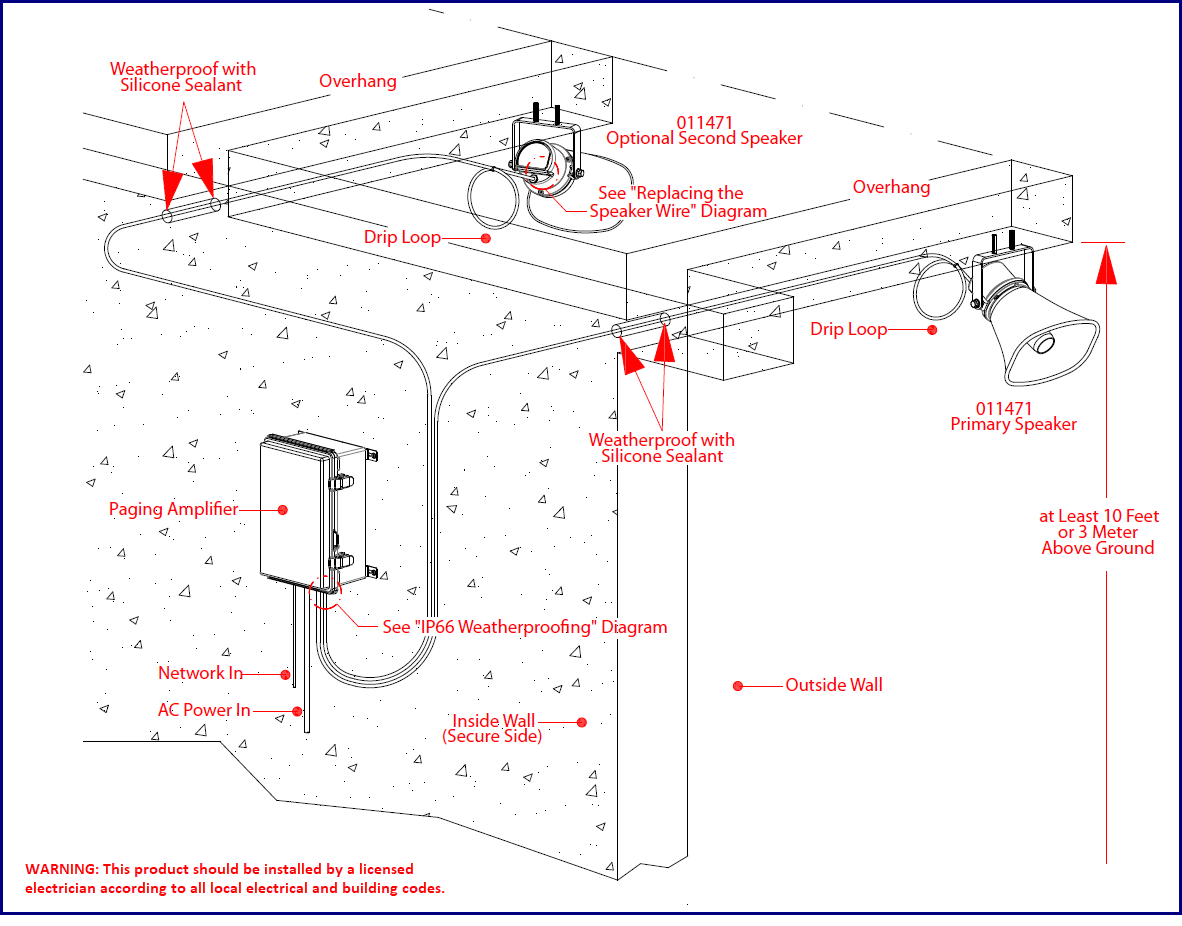
Serial Number begins with 3240xxxxx
Serial Number begins with 3242xxxxx
| Documentation | |
|---|---|
| Description | Date |
| PDF Datasheet | DATE:6/12/23 |
| PDF Quick Start Guide | DATE:2/10/25 |
| PDF Quick-Reference Placemat | DATE:6/12/23 |
| PDF Operations Guide (firmware version 22.0) | DATE:11/19/24 |
| PDF Operations Guide (firmware version 20.5.0) | DATE:6/12/23 |
| PDF CyberData Night Ringer Explained | DATE:3/25/20 |
| PDF CE Declaration of Conformity | DATE:5/15/17 |
| Connecting to Compatible IP-PBX Servers | |
| Firmware, Drivers & Utilities | |
| TERMINUS ZIP Firmware 22.0.1. For more information, see the release notes. *Note* Upgrade will take 6 minutes to complete and cause your device to reboot twice. Device cannot revert to previous versions. | DATE:11/19/24 |
| ZIP Firmware 20.5.0 | DATE:10/18/22 |
| ZIP The Discovery Utility scans the network and reports back any found VoIP devices that are attached to the physical network. | |
Description
The SIP Paging Amplifier is a Power over Ethernet (802.3at) VoIP paging device and loud ringer for use in places that need loud paging. It provides an easy method for implementing an IP-based overhead paging system for your existing or new VoIP Phone system.
Features
- Concurrent SIP and multicast paging
- Loud/Night Ringer function - second SIP extension
- Paging Prioritization
- Support for 10 multicast paging groups
- 9 user-uploadable page messages
- Can receive pages directly from Poly phones as well as other devices that can send standard multicast
- Sense input capable of generating events or SIP calls
- Supports delayed pages, i.e. call buffering
- Support for security code to prevent unwanted SIP calls
- Support for auxiliary strobe
- Line-in for background music
- Line-out connector
- DTMF controlled relay
- Supports up to two 011471 IP66 Analog Horns or other 8 Ohm speaker
- Network volume control
- TLS 1.2 and SRTP enhanced security for IP Endpoints in a local or cloud-based environment
- Autoprovisioning via HTTPS, HTTP or TFTP
- HTTPS web based configuration
- Configurable event generation for device health and status monitoring
- 802.11q VLAN tagging
- HTTPS command interface
- Support for Cisco SRST resiliency
Specs
| Ethernet I/F | 10/100 Mbps |
| Protocol | SIP RFC 3261 Compatible |
| Power Input | PoE 802.3at or 802.3af |
| Audio Output |
802.3at: 117.9 (+/- 0.2) dBC @1M and 1kHz* 802.3af: 115.1 (+/- 0.2) dBC @1M and 1kHz* |
|
Line In: Intput Signal Amplitudes Input Impedance |
2.0 VPP Maximum 10k Ohm |
|
Line Out: Output Signal Amplitudes Output Level Total Harmonic Distortion Output Impedance |
2.0 VPP Maximum +2dBm nominal 0.5% maximum 10k Ohm |
| On-Board Relay | 1A @ 30 VDC |
| Payload Types | G.711 a-law, G.711 µ-law, G.722, and G.729 |
| Network Security | TLS 1.2, SRTP, HTTPS |
| Operating Range |
Temperature: -40 degrees C to 55 degrees C (-40 degrees F to 131 degrees F) Humidity: 5-95%, non-condensing |
| Storage Temperature | -40 degrees C to 70 degrees C (-40 degrees F to 158 degrees F) |
| Storage Altitude | Up to 15,000 ft. (4573 m) |
|
Dimensions** |
1.10 in. [29.0 mm] Length 4.20 in. [107.0 mm] Width 8.50 in. [215.0 mm] Height |
|
Weight Boxed Weight |
1.27 lbs. [0.57 kg] 2.0 lbs. [0.90 kg] |
| Compliance | CE: EMC Directive – Class A EN 55032 & EN 55024, LV Safety Directive – EN 62368-1; RoHS Compliant; FCC Part 15 Class A; Industry Canada ICES-3 Class A; IEEE 802.3 Compliant; TAA Compliant |
| Warranty | 5 Years Limited |
| Part Number | 011324 |
*When used with the optional 011471 IP66 Analog Horn (sold separately)
**Dimensions are measured from the perspective of the product being upright with the front of the product facing you.
FAQs
What is multicast?
IP multicast is a technique for one-to-many communication over a local IP network. IGMP multicast is sent via UDP packets from a multicast server to a multicast receiver. This stream scales to a larger receiver population by not requiring prior knowledge of who or how many receivers there are. Multicast uses network infrastructure efficiently by requiring the source to send a packet only once, even if it needs to be delivered to many receivers. The network replicates the packet in order to reach multiple receivers only when necessary.
Multicast is a great alternative to SIP registration as it does not require that the recipient of the stream to register as an extension on an IP-PBX server.
CyberData products support both regular IGMP multicast as well as proprietary Polycom Group Paging.
How do I update my firmware?
Check to see if your current firmware is the latest version before attempting to update. Download the latest version firmware which includes the Update Firmware Utility. To upload the firmware from your PC, see the Upgrading the Firmware section of the VoIP Paging Amplifier Operations Guide.
For additional support or answers to questions not covered on this page, who should I contact?
Contact CyberData VoIP Technical Support.
How many horns can be connected to an amplifier?
CyberData's VoIP Paging Amplifier supports the following outputs: One 8-ohm speaker: 8 watts One 8-ohm speaker with external PoE power injector (CyberData PN 010867): 10 watts Two 8-ohm speaker in parallel with external PoE power injector (CyberData PN 010867): 16 watts
Are your speakers compliant with RFC 3261?
Yes, our speakers are compliant with RFC 3261, but not every SIP extension is fully supported such as extensions for certain phone features that our speakers do not require.
Do your speakers support other protocols?
Our speakers are SIP endpoints that use the SIP protocol in RFC 3261. Depending on the business case, we will consider custom applications using other protocols. Please contact sales@cyberdata.net for inquiries concerning other protocols.
Our IP-PBX server is RFC 3261 compliant in that it can register other SIP endpoints, so how do I create multiple paging zones using your speakers?
Our speakers do not create multiple zones as this is a feature (SIP extension) of the IP-PBX server. If your IP-PBX server does not support this SIP extension, you can use our Paging Server product to create multiple zones with our speaker.
Which IP-PBX servers do your speakers interoperate with?
Our speakers interoperate with the IP-PBX servers in the following link.
I hooked up your speakers using Asterisk and they play audio individually but why don't they play in a paging group (zone)?
1)Make sure you have installed and loaded a timing source such as Zaptel's "ztdummy" on your Asterisk server.
2) If you are using SIP phones in the same paging group as our speakers and auto-answer is activated for these phones, please upgrade to the latest paging group module in Asterisk, which is 1.2.3 or greater and put an "x" (this removes auto-answer commands our speakers do not use because they are hard-coded to auto-answer) after the extension number for the speakers in the paging group drop-down menu in FreePBX.
What are the Asterisk settings to set up our paging speakers?
For both IP Speaker and the Paging Amplifier, the settings are contained in the sip_additional.conf file in Asterisk. This file should read as follows in which "100" represents the username of our speaker and the password (secret) is ext100:
[100] username=100 type=friend secret=ext100 record_out=Adhoc record_in=Adhoc qualify=no port=5060 nat=never mailbox=100@device host=dynamic dtmfmode=rfc2833 context=from-internal canreinvite=no callerid=100 <100>
How do I set up a page group in Asterisk?
Page groups are found in the extensions_additional.conf file in Asterisk. The paging group portion of this file should read as follows in which "101 and 102" are the usernames and extensions of two speakers and "103" is the extension used to call the paging group of speakers 101 and 102, and "105" is the extension to call speakers 101,102, and 104:
[ext-paging] include => ext-paging-custom exten => PAGE102,1,GotoIf($[ ${CALLERID(number)} = 102 ]?skipself) exten => PAGE102,n,Dial(SIP/102,5) exten => PAGE102,n(skipself),Noop(Not paging originator) exten => PAGE101,1,GotoIf($[ ${CALLERID(number)} = 101 ]?skipself) exten => PAGE101,n,Dial(SIP/101,5) exten => PAGE101,n(skipself),Noop(Not paging originator) exten => PAGE104,1,GotoIf($[ ${CALLERID(number)} = 104 ]?skipself) exten => PAGE104,n,Dial(SIP/104,5) exten => PAGE104,n(skipself),Noop(Not paging originator) exten => Debug,1,Noop(dialstr is LOCAL/PAGE102@ext-paging&LOCAL/PAGE101@ext-paging) exten => Debug,n,Noop(dialstr is LOCAL/PAGE104@ext-paging&LOCAL/PAGE102@ext-paging&LOCAL/PAGE101@ext-paging) exten => 103,1,Page(LOCAL/PAGE102@ext-paging&LOCAL/PAGE101@ext-paging) exten => 105,1,Page(LOCAL/PAGE104@ext-paging&LOCAL/PAGE102@ext-paging&LOCAL/PAGE101@ext-paging); end of [ext-paging]
Are you able to traverse the NAT with your IP paging products?
Our IP paging products are programmed to traverse the NAT using Session Border Controllers (SBCs) of the VoIP hosting company or service provider. The SBCs act as an outbound proxy and manage the SIP traffic between the SIP server and the SIP endpoint behind the NAT. For more information on SBCs, go here.
Is it possible with one Paging Amplifier to have multiple paging groups?
Since the VoIP Paging Amplifier is a single SIP endpoint, it can not have multiple paging groups.
Are the speaker contacts potential-free?
Yes, our loudspeaker outputs are potential free. If no paging input occurs, the outputs is at or near zero voltage.
What are the output levels of the speaker contacts?
The output level is 15 Volt maximum.
What 8 ohm speakers are recommended for the Paging Amplifier?
CyberData's 011068 Loudspeaker.
My speakers are not loud enough. What should I do?
CyberData recommends good quality speaker wire that is 16 gauge and a maximum length of 25 feet. For maximum output, use two 8-Ohm speakers that are wired in parallel with the shortest possible cable length (total combined length should not exceed more than 25 feet). By utilizing the high power jumper settings described in the manual in conjuction with CyberData's PoE Injector, you may achieve additional speaker volume by using either one 8-Ohm speaker or two 8-Ohm speakers in parallel.
How do I configure Music-on-Hold (MOH) for Asterisk?
Use the instructions at the following link to set up MOH for Asterisk: https://www.voip-info.org/wiki-Asterisk+config+musiconhold.conf
We would like to communicate directly to your products. Do you have any open source programs you can recommend to do this?
Yes. Try the following links and also contact CyberData support for help Data format: RTP audio 8k G.711 a/u Law 20ms packet time Open source programs:
MAST: https://www.aelius.com/njh/mast/ MAST can handle ulaw and alaw as well as streaming from a mic to a speaker.Linphone: https://www.linphone.org/index.php/eng Linphone has a test application called rtpsend that streams data out as ulaw by default. (It may be trivial to modify this to send in other formats).
After a period of time, my device stops working or is unreachable.
This is a common problem when the re-registration time value is not set correctly. On our device, you need to make sure that the re-registration time value (in minutes) is less than that is set on the IP-PBX server.
On an Asterisk-based VoIP SIP PBX system, the CyberData SIP Device status is "Busy" or "Unreachable". I have set up both the CyberData VoIP SIP device and the PBX extension information for the device. I can see the device on the network, am able to PING it, and can bring up the device web page with a browser. However, when I try to call it from a phone extension, I see the word "Busy" or "Unreachable" in the Asterisk log.
In the PBX setup page for the extension of the CyberData device, find the Qualify= value and change it to NO. If the Qualify= value requires a numeric value, then change it to 0.
Note that on some Asterisk systems (such as Intuitive Voice) this value is called the Heartbeat= value. Set the Heartbeat= value to NO, and then save the settings.
Also, on the product's SIP Setup page, make sure that the Register Expiration (minutes) setting is set to less than 6 minutes (5 minutes is good) because it needs to be a value less than the Asterisk default value of 6 minutes. Save the settings after changing the Register Expiration (minutes) setting.
I upgraded my 3CX PBX server to 7.1 and now my Rev B CyberData VoIP IP Speaker and My VoIP Paging Amplifier do not stay registered with the server.
There is a 3CX version 7.1 registration / timing bug. To correct this problem, complete the following steps:
1. Log into the 3CX PBX system, and select SETTINGS -> ADVANCED -> CUSTOM PARAMETERS.
2. Scroll down to select the NONCEEXPIRATION parameter.
3. Change the NONCEEXPIRATION value from 1 to 2 and save the changes.
Note: There are pictures of the 3CX PBX pages and parameters at the end of the document at this link.
When connecting two 8 ohm speakers to the product while in standard low power mode, the unit will reset at full volume pages.
The connection of two 8 ohm speakers in parallel under both Standard and High Power Mode require the use of the CyberData PoE injector.
Are there a set of specs. or standards that define proper spacing for your IP Speakers? We need to determine the proper number of speakers for our buildings' corridors. I am looking for something that considers ceiling height and room size/shape to suggest the appropriate quantity.
The speaker calculator on your website seems sufficient for square rooms. It is hallways that I am struggling with. The hallways measure 9 feet x 9 feet by 100-150 feet in length.
In a ceiling mount, you would want about 1 per every 10-15 feet of hallway length.
If you used the paging amp you could use 3 paging amps per 100 feet as per this drawing.
This assumes average ambient noise and surface attenuation levels.
The following figure shows the 011061 V2 Paging Amp and the 011068 Horn Loudspeaker:

I am unable to connect with the unit when it is plugged into a Cisco SLM 224P switch.
The cables or switch ports that you are connecting to are set in switch or hub mode instead of endpoint stations. The MDIX setting needs to be changed to MDI since our VoIP products are end stations.
From the Cisco SLM 224P User Guide:
Change to MDI:
MDI / MDIX Â Displays the Media Dependent Interface (MDI) / Media Dependent Interface with Crossover (MDIX) status on the port. Hubs and switches are deliberately wired the opposite of the way end stations are wired, so that when a hub or switch is connected to an end station, a straight through Ethernet cable can be used, and the pairs are matched up properly. When two hubs or switches are connected to each other, or two end stations are connected to each other, a crossover cable is used to ensure that the correct pairs are connected. The possible field values are:
MDIX Â Use for hubs and switches. MDI Â Use for end stations.I have a Cisco 6513 switch. When I plug in a CyberData VoIP device, the device constantly reboots and will not register to the SIP server.
Please adjust the switch power selection to Power inline static, as opposed to Power inline dynamic. This will allow the device to continuously receive 15.4W of power.
How do I connect a 600 Ohm Lo-Z input or output to the V2 Paging Amplifier's Line Input or Output?
The V2 Paging Amplifier's Line Input and Output can be connected to a 600 Ohm Lo-Z input or output using a Hi-Z to Lo-Z impedance matching transformer. For example, the Bogen WMT1A input matching transformer is an easy to use, inexpensive solution that does not require soldering or complex wiring.
We have registered the device on Cisco Call Manager but are unable to register the device's Nightringer using the device's MAC address. How do I configure two extensions on Call Manager for the device?
Create a second directory number and user for the Nightringer extension. You may need to fudge a digit of the MAC Address so that Call Manager allows you to associate it to the new user. Be sure this MAC address does not match any other CyberData devices on your network.
I have a Cisco Catalyst 2900 series switch. How do I set the unit so that it can use the PoE (under 15.4w) instead of an external power source?
There are known PoE limitations with third party devices on the Cisco Catalyst series switches. This includes the 2500, 3500, and 6500 series switches. It would be best to avoid using the Cisco Catalyst series switches to power the amplifier and use an 802.3at injector. If you have a 2960-S series switch with PoE+ ports, we recommend that you use those instead of PoE and set the amplifier to High Power mode.
High Power mode DIP switch settings: 1
ON 2 N/A 3 OFF 4 ONBe sure to turn power policing off if it has been enabled on your switch. Power policing is disabled by default. Also, configure your port for no shutdown.
Use the following command to configure inline power: power inline static max 30000
I am looking for an approved panic button to connect to your amplifiers that has a cover over the panic button to avoid accidental pressing and also one that may be waterproof for outside use.
See the following webpage for a nice selection: https://www.sti-usa.com/pcategories/waterproof_buttons_and_switches/
Installation
Typical Installation 
Connecting the Auxiliary RGB Strobe Kit to the Paging Amplifier 
Low Power Mode One Speaker 
High Power Mode One Speaker 
High Power Mode Two Speakers 
Typical Warehouse Paging Setup 
Replacing the Speaker Wire
Suggested Outdoor Installation for Security
Downloads
Serial Number begins with 3240xxxxx
Serial Number begins with 3242xxxxx
| Documentation | |
|---|---|
| Description | Date |
| PDF Datasheet | DATE:6/12/23 |
| PDF Quick Start Guide | DATE:2/10/25 |
| PDF Quick-Reference Placemat | DATE:6/12/23 |
| PDF Operations Guide (firmware version 22.0) | DATE:11/19/24 |
| PDF Operations Guide (firmware version 20.5.0) | DATE:6/12/23 |
| PDF CyberData Night Ringer Explained | DATE:3/25/20 |
| PDF CE Declaration of Conformity | DATE:5/15/17 |
| Connecting to Compatible IP-PBX Servers | |
| Firmware, Drivers & Utilities | |
| TERMINUS ZIP Firmware 22.0.1. For more information, see the release notes. *Note* Upgrade will take 6 minutes to complete and cause your device to reboot twice. Device cannot revert to previous versions. | DATE:11/19/24 |
| ZIP Firmware 20.5.0 | DATE:10/18/22 |
| ZIP The Discovery Utility scans the network and reports back any found VoIP devices that are attached to the physical network. | |



